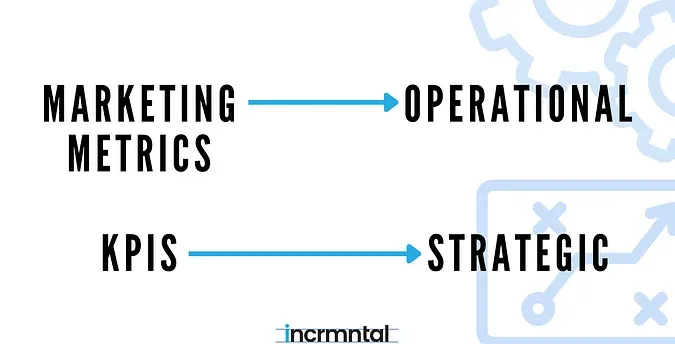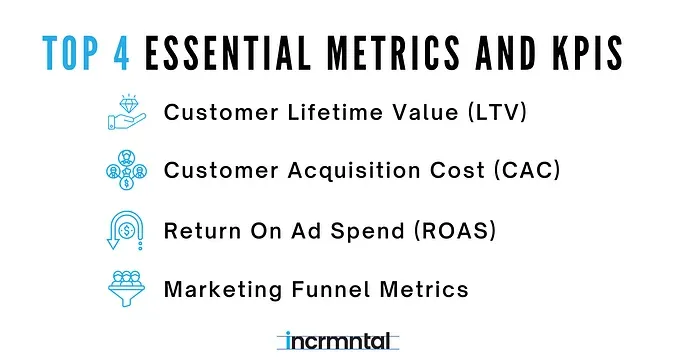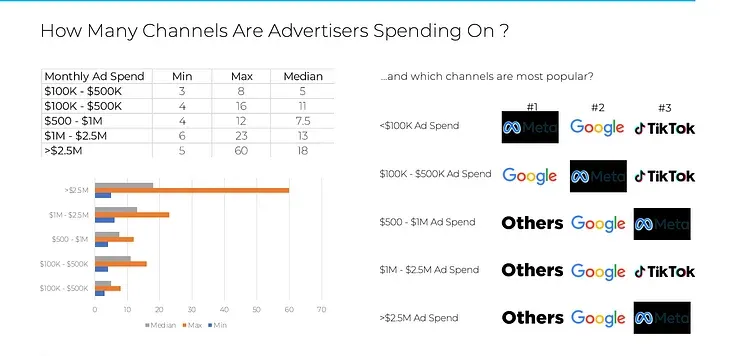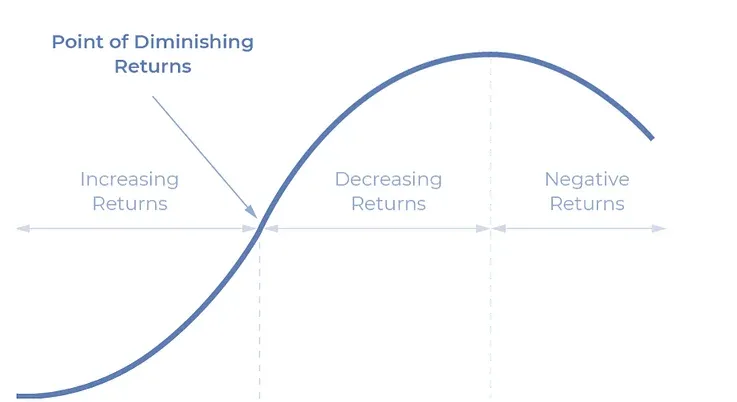Platform
Use Cases
Many Possibilities. One Platform.
AI and Automation
The Always-on Incrementality Platform
Solutions
Teams
Built for your whole team.
Industries
Trusted by all verticals.
Mediums
Measure any type of ad spend
Use Cases
Many Possibilities. One Platform.
AI and Automation
The Always-on Incrementality Platform
Teams
Built for your whole team.
Industries
Trusted by all verticals.
Mediums
Measure any type of ad spend

Impressions, followers, conversions, leads… When it comes to marketing metrics, today’s marketers are wealthy in choices for data. But, having more data to sort through makes it even more important to be selective when choosing the right metrics and KPIs. Being able to digest nitty-gritty data into big-picture behavioral patterns is an asset to any organization.
CMOs are under more pressure than ever to show the direct impact of the marketing initiatives they oversee on the business. According to Forbes, data will play a crucial role in providing accountability and insights to CMOs. For the data-driven marketer, choosing the right marketing metrics and KPIs to report to your CMO will become an increasingly crucial skill in the coming years.
Marketing metrics and KPIs 101
Marketing metrics and KPIs are frequently used interchangeably but differ in minor ways. A marketing metric is any quantifiable indicator used to track the performance of a marketing activity or campaign. KPIs, on the other hand, are quantifiable indicators used to measure performance on key business goals.
To make it even simpler: both measure the performance of marketing activities, but consider marketing metrics as operational, while KPIs are strategic.

Some examples of marketing metrics and KPIs that most marketers will be familiar with are:
1. Traffic: the number of visitors to a website.
2. Conversion rate: the percentage of visitors who complete a certain action, such as filling in a form.
3. Click-through rate (CTR): the percentage of people who click on a link or call-to-action button.
4. Engagement rate: the aggregation of likes, comments, and shares a piece of content receives on social media.
When choosing which marketing metrics and KPIs accurately measure the impact of your marketing activities on the business, it’s best to avoid vanity metrics. Vanity metrics are those metrics that look impressive, but that do not help you understand your own performance in a way that helps you make decisions for future strategies.

As for the marketing metrics and KPIs that you should consider essential, consider those that demonstrate how marketing and advertising activities have a direct impact on the business. Here are our top 4.
What is it? The customer lifetime value (abbreviated as CLV or LTV) is the predicted total net profit a customer will bring to a business, over the entire course of the relationship.
How is it calculated? LTV is calculated using: the value of a customer's purchase, the amount of time a customer is expected to continue making purchases, and the customer's potential profitability.
Why is it an essential metric? Predicting your LTV helps you determine how much can be spent on getting in new customers, as well as retaining existing ones. This metric is crucial in letting your CMO know how to allocate resources more efficiently, as well as inform strategic decisions in sales, marketing, and customer service.
What is it? Customer Acquisition Cost (or CAC) is the cost to acquire a new customer.
How is it calculated? CAC is calculated by taking the total campaign spend and dividing it by the number of acquired customers.
Why is it an essential metric? Knowing how much it costs to acquire new customers is a quick way to have a general indication of how a campaign is performing. This helps in monitoring the overall effectiveness and value of a campaign, from a customer-focused perspective.
What is it? Return On Ad Spend (ROAS) is a metric used to measure the profitability of sales vs. the money spent on marketing campaigns. ROAS moves marketers away from customer-centric metrics, shifting the focus toward revenue.
How is it calculated? ROAS are calculated by looking at total revenue and matching it up to total campaign spend, measuring only immediate revenue that comes directly from specific campaigns.
Why is it an essential metric? Businesses want to know whether the money they invest in marketing campaigns is worth it. By focusing on immediate revenue resulting from direct campaigns, ROAS allow marketers to show how effective their campaigns are in creating tangible profit.
What is it? Funnel metrics are metrics that count the events triggered by a user, at each step of the marketing funnel.
How is it calculated? Funnel metrics track distinct events and users per day. If a funnel has multiple events (event A > event B > event C), user-based funnel metrics help marketers keep track of the number of users triggering each event, and when.
Why is it an essential metric? Funnel metrics are a great way to help you understand how effective your marketing funnel truly is. By tracking user behavior across multiple events, marketers can better understand the events that are converting and adjust those that need optimizing.

Before knowing which metrics are valuable to accurately measure the impact of your campaigns, you need to define and understand your marketing and business goals. Assuring your marketing goals fall in line with your business goals will have you one step closer to setting metrics and KPIs that provide real value to your CMO.
An important step in setting these goals is knowing who your target audience is and what actions you want them to take. This is a crucial step in identifying the correct marketing metrics and KPIs for you. For example, for a brand awareness campaign where the goal is to get your brand out there, a large number of website visits would be a valuable metric. But, if your aim was to convert visitors into paying customers, other metrics, such as lead conversion rates, would be much more fitting.
The “where” is equally as important. Marketers today rely on multiple channels to reach their target audiences. Think carefully about what channels you want to include in your marketing mix.
Once you know what business goals you’re supporting, who you’re targeting, what you want them to do, and where you’re reaching them, it’s time to define your marketing goals. Keeping them SMART (specific, measurable, achievable, relevant to your business, and time-bound) is a good way to make sure your goals are clear.
Setting clear and realistic goals is crucial to better understanding what marketing metrics you should be reporting. But, that’s only the first step.
A key benefit of most marketing measurements available today is that it’s dynamic. It’s not enough to set goals, but, to make the most of their data, marketers need to continuously optimize campaigns based on new insights.
It’s important to choose a strategy that allows space for optimization. One such strategy? Diversifying your marketing mix through omnichannel marketing.
Omnichannel marketing is ripe for optimization opportunities, as it allows you to collect and analyze data from several customer touchpoints. This gives useful insight into their behavior across multiple channels. Let’s dive into how it could be optimized.
Optimizing your omnichannel marketing
An omnichannel marketing approach gives marketers the chance to cast a wider net, provide a more seamless customer experience, and even tap into niche target audiences. But, not all channels should be treated equally.
By keeping up to date with the latest trends and understanding the performance of your channels, you can adapt your campaign and strategy in real time. When it comes to omnichannel marketing, some recent developments that we’ve seen are that in the last three months, there has been a decline of spend on Google, while Meta has maintained in the same place. TV is showing itself to be a fast-growing channel, proving itself to be more and more popular amongst marketers and advertisers.
By taking stock of what other advertisers are spending on and what channels they’re choosing for, you can optimize and adapt your goals, as new information rolls in.
An omnichannel marketing approach gives marketers the chance to cast a wider net, provide a more seamless customer experience, and even tap into niche target audiences. But, not all channels should be treated equally.
By keeping up to date with the latest trends and understanding the performance of your channels, you can adapt your campaign and strategy in real time. When it comes to omnichannel marketing, some recent developments that we’ve seen are that in the last three months, there has been a decline of spend on Google, while Meta has maintained in the same place. TV is showing itself to be a fast-growing channel, proving itself to be more and more popular amongst marketers and advertisers.
By taking stock of what other advertisers are spending on and what channels they’re choosing for, you can optimize and adapt your goals, as new information rolls in.

Knowing when enough is enough by leveraging diminishing returns is another way to optimize your omnichannel marketing strategy. In marketing, diminishing returns are the point at which the return on every additional dollar spent is no longer as cost-effective as the previous dollar.

Understanding diminishing returns is understanding “what is the maximum we should be spending across this channel?”. Incrementality can help answer this question. Traditional forms of incrementality, such as A/B testing, can provide an answer, but be difficult to carry out. Here’s where incrementality using Causal Data Science can help marketers in setting the right spend levels for the channels in use, maximizing yield. This is done by measuring the incremental value of each point of increasing spend, revealing the incremental value of each point in time.
The proliferation of marketing platforms, programs, and tools can make it tricky to narrow down which marketing metrics to choose. Just knowing what metrics are most popular and what they do isn’t enough. The data-driven marketers of today need to go one step beyond and recognize which metrics show the tangible effects of marketing activities on the business, by setting clear goals and being willing to continuously optimize. The marketer that does, will know exactly what marketing metrics and KPIs to report to your CMO this time.
INCRMNTAL is an incrementality testing platform that uses machine learning and AI to provide incrementality and cannibalization insights to Advertisers, unlocking the full value of their marketing budget. Over on INCRMNTAL’s blog, we share insights into the world of meaningful marketing measurement - giving answers to the questions marketers really want answered. We always want to hear from marketer's themselves, so let us know: how do you set your KPIs and what advice would you give that we may have missed?

Maor is the CEO & Co-Founder at INCRMNTAL. With over 20 years of experience in the adtech and marketing technology space, Maor is well known as a thought leader in the areas of marketing measurement. Previously acting as Managing Director International at inneractive (acquired by Fyber), and as CEO at Applift (acquired by MGI/Verve Group)